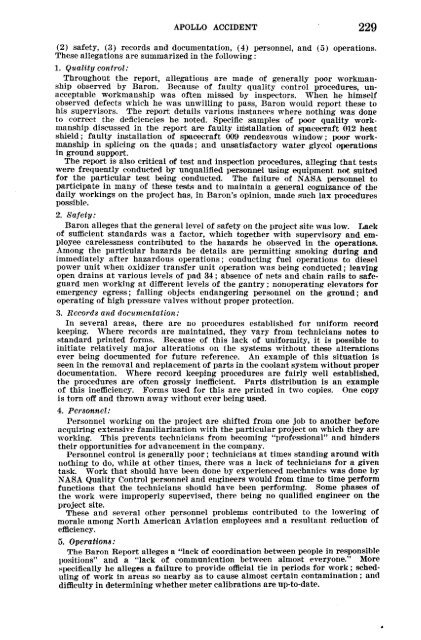Colonel BORMAN. Sir, I would be remiss if I did not admit that I ani ...
Colonel BORMAN. Sir, I would be remiss if I did not admit that I ani ...
Colonel BORMAN. Sir, I would be remiss if I did not admit that I ani ...
You also want an ePaper? Increase the reach of your titles
YUMPU automatically turns print PDFs into web optimized ePapers that Google loves.
APOLLO ACCIDENT 229<br />
(2) safety, (3) records and documentation, (4) personnel, and (5) operations.<br />
These allegations are summarized in the following :<br />
1. Qualitu control:<br />
Throughout the report, allegations are made of generally poor workmanship<br />
observed by Baron. Because of faulty quality control procedures, unacceptable<br />
workmanship was often missed by inspectors. When he himself<br />
observed defects which he was unwilling to pass, Baron <strong>would</strong> report these to<br />
his supervisors. The report details various instances where <strong>not</strong>hing was done<br />
to correct the deficiencies he <strong>not</strong>ed. Spec<strong>if</strong>ic samples of poor quality workmanship<br />
discussed in the report are faulty in’stallation of spacecraft 012 hat<br />
shield ; faulty installation of spacecraft 009 rendezvous window ; poor workmanship<br />
in splicing on the quads; and unsatisfactory water glycol operations<br />
in ground support.<br />
The report is also critical of test and inspection procedures, alleging <strong>that</strong> tests<br />
were frequently conducted by unqual<strong>if</strong>ied personnel using equipment <strong>not</strong> suited<br />
for the particular test <strong>be</strong>ing conducted. The failure of NASA personnel to<br />
participate in many of these tesits and to mainbain a general cognizance of the<br />
daily workings on the project has, in Baron’s opinion, made such lax procedures<br />
possible.<br />
2. Safety:<br />
Baron alleges <strong>that</strong> the general level of safety on the project site was low. Lack<br />
of sufficient standards was a factor, which together with supervisory and employee<br />
carelessness contributed to the hazards he observed in the operations.<br />
-4mong the particular hazards he details are permitting smoking during and<br />
immediately after hazardous operations ; conducting fuel operations to diesel<br />
power unit when oxidizer transfer unit operation was <strong>be</strong>ing conducted ; leaving<br />
open drains at various levels of pad 34 ; absence of nets and chain rails to safeguard<br />
men working at d<strong>if</strong>ferent levels of the gantry ; nonoperating elevators for<br />
emergency egress ; falling objects endangering personnel on the ground ; and<br />
operating of high pressure valves without proper protection.<br />
3. Records and documentation:<br />
In several areas, there are no procedures established for un<strong>if</strong>orm record<br />
keeping. Where records are maintained, they vary from technicians <strong>not</strong>es to<br />
standard printed forms. Because of this lack of un<strong>if</strong>ormity, it is possible to<br />
initiate relatively major alterations on the systems without thee alterations<br />
ever <strong>be</strong>ing documented for future reference. An example of this situation is<br />
seen in the removal and replacement of parts in the coolant system without proper<br />
documentation. Where record keeping procedures are fairly well established,<br />
the procedures are often grossly inefficient. Parts distribution is an example<br />
of this inefficiency. Forms used for this are printed in two copies.<br />
One copy<br />
is torn off and thrown away without ever <strong>be</strong>ing used.<br />
4. Personnel:<br />
Personnel working on the project are sh<strong>if</strong>ted from one job to a<strong>not</strong>her <strong>be</strong>fore<br />
acquiring extensive familiarization with the particular project on which they are<br />
working. This prevents technicians from <strong>be</strong>coming “professional” and hinders<br />
their opportunities for advancement in the company.<br />
Personnel control is generally poor ; technicians at times standing around witli<br />
<strong>not</strong>hing to do, while at other times, there was a lack of technicians for a given<br />
task. Work <strong>that</strong> should have <strong>be</strong>en done by experienced mech<strong>ani</strong>cs was done by<br />
NASA Quality Control personnel and engineers <strong>would</strong> from time to time perform<br />
functions <strong>that</strong> the technicians should have <strong>be</strong>en performing. Some phases of<br />
the work were improperly supervised, there <strong>be</strong>ing no qual<strong>if</strong>ied engineer on the<br />
project site.<br />
These and several other personnel problems contributed to the lowering of<br />
morale among North American Aviation employees and a resultant reduction of<br />
efficiency.<br />
5. Operations:<br />
The Baron Report alleges a “lack of coordination <strong>be</strong>tween people in responsible<br />
positions” and a “lack of communication <strong>be</strong>tween almost everyone.” More<br />
hpec<strong>if</strong>ically he alleges a failure to provide official tie in periods for work ; scheduling<br />
of work in areas so nearby as to cause almost certain contamination ; and<br />
d<strong>if</strong>flculty in determining whether meter calibrations are np-to-date.
















